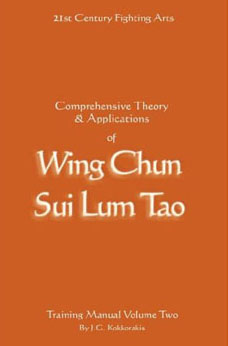|
Yee Jee Kim Yeung Ma
 Here is a small exert from my second book on the
Sui Lum Tao. Each action of the form is explained in the same detail as what you
can read here. The aim of the book series is to help beginners with little or no
access to a teacher gain a deeper understanding of training methods and
applications of the system. -J.K. Here is a small exert from my second book on the
Sui Lum Tao. Each action of the form is explained in the same detail as what you
can read here. The aim of the book series is to help beginners with little or no
access to a teacher gain a deeper understanding of training methods and
applications of the system. -J.K.
The basic stance in
the system gives incredible stability to the user. When this stance is
understood, it is possible to take pressure pushing the body and redirect it
into the ground. The aim is to find the optimum position in your balance so you
will be ready to absorb this force even when not strictly in the stance.
Performing its actions over some years will give you the ability to perform its
intended purpose from practically any position. This can only be achieved when
you can literally feel and route the pressing force that is applied to you.
When starting the form, stand with your feet together and get a sense of your
balance and weight sinking into the spot you are stood on while simultaneously
pulling your arms back, fists clenched tightly and held one inch from the sides
of your chest. From this position you can begin to go into the Yee Jee Kim Yuen
Ma stance. Sink your body by bending your knees so they line up with the front
of you toes. Then turning on your heels, create a 'V' by turning your toes
outwards. Then place your bodyweight over the balls of your feet and turn your
heels outward. From here, your feet are pointing in and form an imaginary
triangle, the point of which is where your opponents centre will be. Once in
this position, you angle your pelvis up slightly and relax your bodyweight into
the stance, holding it all together with a slight muscular tension in the
buttocks. Keep your back straight, chin up and chest held slightly forwards.
Caution! Sinking too far can put a strain on your knees, which can cause injury,
so be careful and only sink as far as is comfortable.
Once in the stance, the weight of the body can be held over the heels or middle
of the feet. When over the middle of the feet, connection to the ground is felt
between the heel and balls of the feet, with balance concentrated over the
arches of the feet. If we are pressed by the opponent, our body structure and
stance can absorb the pressing force while we remain balanced and rooted to the
floor. But if pressed hard, we can move onto our heels and then rotate or apply
a structure to deal with the pressing force. There is buoyancy in this stance
that exists at the knees. If done correctly, the stance should feel very
comfortable and can be maintained for long periods of time, effortlessly. If
great weight or pressure is placed on the hips, the knees can absorb this force
until the feeling of pressing out from the floor exists.
There are several methods for standing in this stance. One way is to stand with
the chest in line with the toes, as this gives you an upright posture that you
can instantly move forward or backwards from. If you are pulled forward, your
leg simply steps ahead of your torso. The same principle is applied if pushed
back. To do this correctly, you will have a slight tension in your hips, which
should be there naturally as you hold your hips angled up. This tension will
propel the correct leg forward or backward in relation to where you are being
pulled or pushed.
The same principle applies if slowly and gradually pressed. If the pressure on
your chest suddenly disconnects, your legs will spring you out from the floor
and in the direction of the pressing force, one leg will move forward and you
will arrive in a strong, forward stance. If on the other hand the pressure on
your chest is too great, you can simply turn the pelvis and torso and redirect
that pressure away from your centre or step back.
Once in the stance you should maintain your balance and posture. When training
with a partner, never allow yourself to overextend or give your balance away. If
during exercises you are pulled or pushed, try to maintain your position. Avoid
leaning backwards or forwards by rotating your torso to dissipate force or
stepping with the
direction of force. If your arm is pulled, i.e. by a Lap Sao, try applying a
Huen Sao to break free of the grip or move forward with the pull and attack with
your shoulder. It is important that you do not get used to poor posture or allow
a partner to constantly compromise your positioning. Balance, rooting and
posture are the key to developing power for striking and controlling the
opponent.
Jason Kokkorakis.
 |
Yip Man ->
Yip Chun ->
Colin Ward
+ others
Yip Man ->
Wong Shun Leung -> Clive Potter / Others
Yip Man ->
Duncan Leung -> Frank Grispo |
|
About the Author:
homepage |
Copyright (c) 2006 the Wing Chun Archive and
Jason Kokkorakis 12/30/06
|
